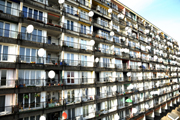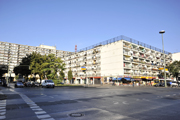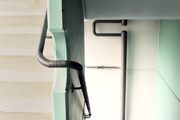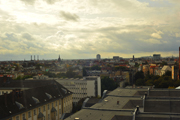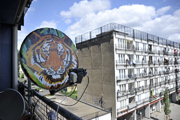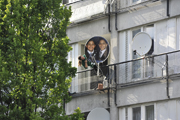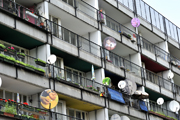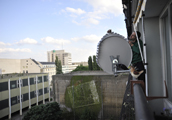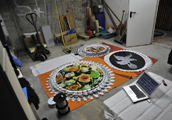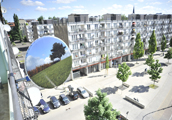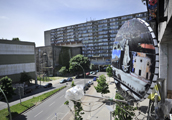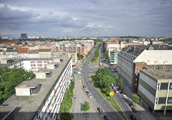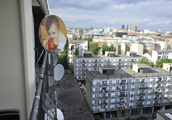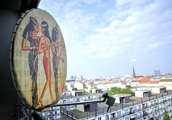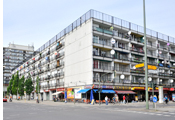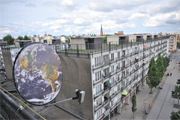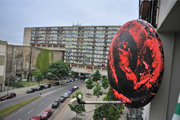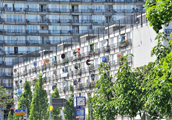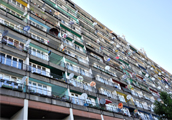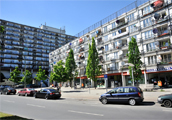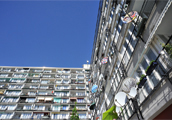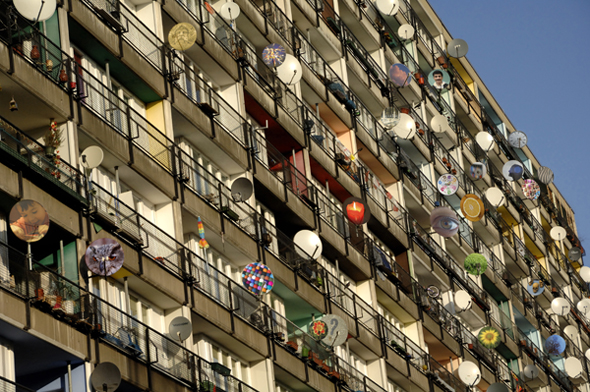
Inside Out
(2008-2010) Multicultural households set indication
More information about "Inside Out" you find at Stadtteilverein Schöneberg e.V. and Quartiermanagement Schöneberger Norden
Introduction to the artistic basic ideas:
The satellite dish and/or the parabolic antenna serve a lot of households as a television receiver and are not only widespread in concentrated multicultural areas. In households with migration background, this receiver is more, than only the possibility to receive undisturbed TV-programs.
For me this aerial also embodies a strong symbol. This satellite dish creates a connection between the present place of residence of a person and his original homeland. It delivers thousands of information, pictures and maintains in cultureclose manner. The aerial enables the users to stay in contact with their culture. Could it also prevent, however from building up new contact? In this project "Inside Out" it is about a reversal. The receiver becomes the transmitter.
Is this "dish" also a symbol of a failed integration? Or is it only one normal connection in a multinational community? Can the right of information, manifested in the basic law, also cause isolation?
These and similar questions I asked myself for the first time in 2006 when I visited the migrant's hostel in Ehingen. There I got to know several refugee families. These meetings played an important role in the development of this art concept. It struck me that the small house in which these families were accommodated was loaded with such "satellite bowls". The inhabitants of the house predominantly watched the television programs of their origin countries and thereby remained close-knit with their native countries. Interestingly the "home program" seemed to be of high importance, particularly to the older generations who had not grown up in Germany.
In the discussions with the people living there, I realized how little I had thought about the subject of integration before. These people and their problems had been invisible for me and I had the feeling one must begin to set visible signs.
About my artistic idea:
My artistic plan developed from the idea to do an artistic project to transform these "dish aerials" which are directed into the outside world. As expression media I chose photography.
It wasn't only about doing a sort of beautification to get an artistically valuable building. My interest was focused on the question, who exactly was hidden behind these receivers? I asked myself: "How would families living behind the receiving walls create their "satellite dish" themselves? How did the people want to be "seen" or what picture would they like to send out? Which "sign" which "message", would the families like to display?"
The dish aerial, as a usable surface to set a sign of own identity? Or could it even lead to a non-verbal kind of intercultural dialogue?
Therefore through these aerials, transformed to art objects, I wanted to draw the attention to urban areas, and stimulate an intercultural dialogue.
During a trip to Berlin the Pallasseum struck me: In the middle of town hundreds of the parabolic reflectors were sucking up pictures and news from all over the world. With the first investigation I got to know some of the international neighborhood in the house. Fascinated by these multicultural surroundings I decided the Pallasseum was perfect and developed my draft for the Pallasseum in Berlin.
With Mr. Fritsch and Mrs. Witthöft of the Pallasseum Wohnbauten KG and the employees of the Quartiersmanagement Schöneberger Norden and the Stadtteilverein Schöneberg I found open minded people, enthusiastic to support my artistic thoughts by the end of the year 2008.
The project "Inside Out" started in summer 2009. During several personal meetings and house visits the inhabitants of the Pallasseum dealt with the idea. After initial skepticism they resolved predominantly, 79 families decided to take part and to make the aerials available for the project. The people involved in this project got the opportunity to get into a creative process concerning their families, their direct surroundings and their origin in an artistic way.
The participants became artists themselves, as they developed their personal ideas and started to set visible indications.
With this art project different subjects were tied together, were promoted and demanded. These subjects are among other themes communication, creativity, identity, integration and urbanity.
Among the house inhabitants, the transformed aerials created numerous establishing points for exchange and communication. Now they are proud of the image that the changed facade leaves and proud of their message to the world.
The changing process of the house front happened in partial steps and offered space to reflect how art can change the district and the neighborhood relations.
HP: The installation on the Pallasseum is still in progress and developing. Several families have now decided to join this new bigger picture, after feeling the impact.
